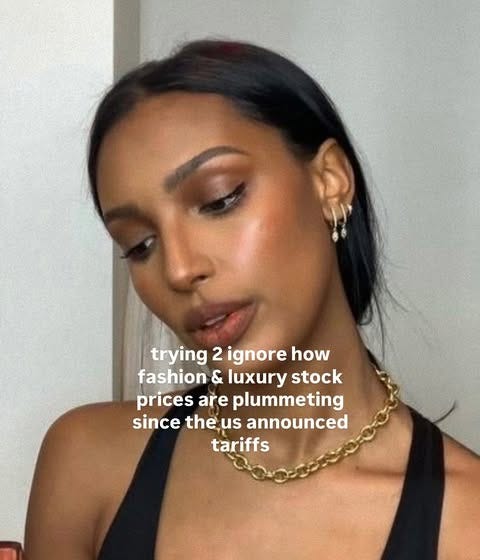Not to get all Wolf of Wall Street, but the stock market is in shambles, babes. And if my calculations are correct, beauty is down bad. So why does that matter when there’s waaaaay bigger problems to worry about? Well, in times of economic ruin, beauty usually prevails.
The “lipstick effect” theory suggests that during a recession or economic downturn, consumers—mostly women—are willing to spend money on small luxuries because it provides emotional support. Call it self-care spending or retail therapy, but people don’t generally mind buying small treats, like lipstick, for a quick hit of serotonin.
The “lipstick effect” isn’t just a new phenomenon, either. During The Great Depression, women clamored for cosmetics, which, as cosmetic historian Gabrelia Hernandez once told me, makeup wasn’t as accessible or even as acceptable to wear as it is today, so the demand was a big deal.
At the time, women believed it would help secure work (looking good = higher chances of getting hired), plus it acted as a cheap form of escapism. Imagine going from Daisy Buchanan to Daisy Buchan’t buy anything??? It’s no wonder that bullet lipstick became a valuable possession.
Then World War II hit, and women were encouraged to buy cosmetics. Not at first, of course, with materials only being made for the war efforts, but when the government noticed a decline in women’s morale, they allowed cosmetic production. Wearing red lipstick not only lifted their spirits, but it became an act of patriotism. (Hitler famously hated red lipstick, so it was a f—k you.) One official from the Ministry of Supply told British Vogue, “Cosmetics are as essential to women as a reasonable supply of tobacco is to a man.”1
Fast forward to 2001 and Leonard Lauder, the chair of Estée Lauder at the time, noted that following the terrorist attacks of September 2001, his company sold more lipsticks than usual. (Fun fact: He used the term the “lipstick effect” to explain the uptick in business, which is why he’s typically credited with it, but Juliet B. Schor first coined the term in her 1997 book The Overspent American.)
Six years later, during The Great Recession, cosmetics, once again, increased in sales. And finally, amid the COVID-19 pandemic, beauty boomed like never before with an increase in skincare, body care, and personal care.
But with that orange man enforcing new tariffs, I’m not quite sure the “lipstick effect” will hold up this time.
For one, the biggest beauty conglomerates reported declining sales before the tariffs went into effect, per Business of Fashion. Estée Lauder Companies, Shiseido, L’Oréal, and Coty (who own tons of your favorite brands) recently revealed that their profits drastically decreased compared to previous years. The beauty slowdown, they’re calling it, has even hit the most beloved brands: Drunk Elephant, Tom Ford, CeraVe, and E.l.f. Beauty, with the latter losing more than 20 percent of its value.
While none of these conglomerates can pinpoint an exact reason for declining sales, they have indicated economic uncertainty as a factor. Between inflation and massive layoffs, people are barely affording everyday necessities. They’re now rationing their spare change for an extra pump of gas or a can of beans, not $12 lipstick.
Not to mention, people are burnt out by the oversaturated market and pressure to consume. They’re realizing that a 10-step skincare routine is not only unnecessary, but not financially sustainable. And at this rate, many already have what they need and plenty of what they don’t.

More interestingly, I’ve noticed that social media trends are now all about scaling back. The “no-mascara trend” has gained momentum this year alone, cutting out what used to be people’s “must-have” product from their everyday routine. And women are even embracing their natural brunette hairstyles (ring the alarms!!!). “Recession blonde” has hit the scene, and having dark hair is cool now because, as the name suggests, it’s too f—king expensive to dye it another color.
With the new tariffs going into effect, it will only exacerbate the decline of beauty sales. If people didn’t want to spend money on mascara a couple of months ago, then they surely won’t want to now. Especially since there’s a 34% tariff on China, a 25% tariff on South Korea, a 24% tariff on Japan, and a 20% tariff on the European Union—countries we typically import cosmetics from.
Even brands made in the U.S. rely on components, lab testing, and even ingredients from other countries, per Allure. And let’s just say that a U.S. brand only uses American materials, ingredients, etc., they’ll still likely increase their prices to compete with the market.
So, how will the “lipstick effect” play out this time? I think people will buy beauty products out of necessity and function, meaning they’ll restock a moisturizer (a.k.a. the necessity) that offers multi-purpose use (a.k.a. the function): like added SPF or primer-like properties to prep makeup, or a cocktail of benefits that allows them to skip serum, eye cream, etc. And if the moisturizer makes them feel better or adds a spark of joy, then it’s simply an added perk, but not the reason they’re spending their spare change on it.
I predict beauty brands will also release more multi-purpose products or curated collections (i.e., encouraging 3-step routines instead of 10) because many won’t be able to handle the increased costs of manufacturing and importing. But as the saying goes, only time will tell.
Rachel Felder’s Red Lipstick book






this is so interesting!!